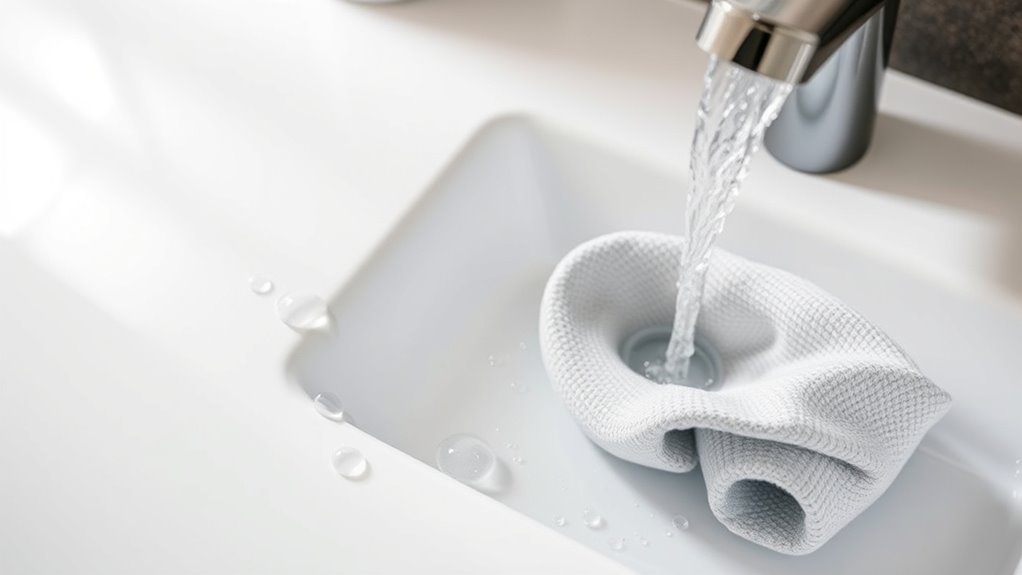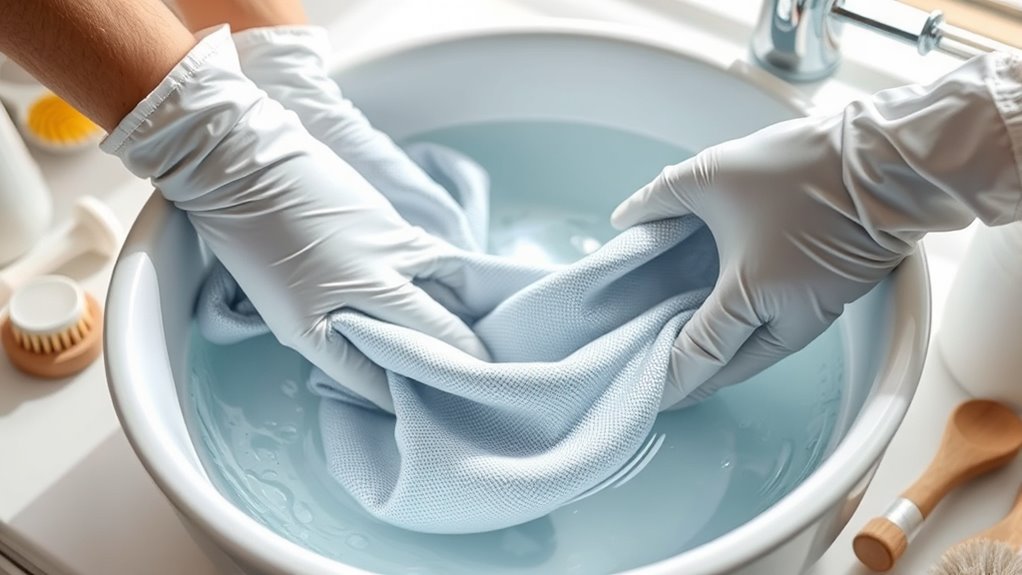To make your technical fabrics last, follow the manufacturer’s washing instructions carefully. Use cold or lukewarm water with mild, fabric-specific detergents, and avoid softeners or bleach. Always handle your gear gently, rinse thoroughly, and air dry in shaded areas to prevent damage. Reapply water-repellent treatments as needed to keep fabrics performing their best. Proper care keeps your gear resilient against water, stains, and wear—continue to discover more tips for lasting performance.
Key Takeaways
- Always follow manufacturer’s instructions and use mild, fabric-specific detergents for cleaning technical fabrics.
- Wash in cold or lukewarm water on a gentle cycle to prevent damage and preserve fabric properties.
- Dry by air in shaded areas, avoiding high heat and direct sunlight to maintain water repellency and fabric integrity.
- Remove stains promptly with gentle blotting and appropriate stain removers, testing on small areas first.
- Reapply water-repellent treatments regularly to sustain water resistance and protect fabric performance.

Technical fabrics require special care to maintain their performance and longevity. These fabrics are designed to be durable, lightweight, and resistant to elements like water, wind, and stains. To keep them performing at their best, you need to understand how to properly care for and wash them. One key aspect is preserving fabric durability, which involves gentle handling and avoiding harsh chemicals that can break down fibers over time. Proper stain removal techniques are equally important, as stubborn stains can compromise fabric integrity if not treated correctly.
Proper care and gentle handling preserve the durability and performance of technical fabrics.
When washing technical fabrics, always follow the manufacturer’s instructions. Most are best washed in cold or lukewarm water on a gentle cycle to prevent damage to the delicate water-resistant coatings or breathable membranes. Using a mild detergent specifically formulated for technical gear is essential; regular detergents can leave residues that diminish water repellency and interfere with fabric performance. Avoid fabric softeners and bleach, as these can weaken fibers and reduce the fabric’s ability to wick moisture or resist stains. Instead, opt for a cleaner designed to preserve the fabric’s original properties.
Stain removal techniques are critical for maintaining the look and function of technical fabrics. When you encounter stains, act quickly to prevent them from setting. Gently blot the stain with a clean cloth or sponge, avoiding scrubbing, which could damage the fabric’s surface. For tougher stains, apply a small amount of stain remover or a mixture of water and mild detergent directly to the affected area. Let it sit for a few minutes before rinsing thoroughly. Always test stain removal products on a small inconspicuous area first to ensure they won’t harm the fabric’s coating or finish. After cleaning, make sure the fabric is fully rinsed to remove any residue that could compromise its breathability or waterproof qualities.
Drying is another essential step. Air drying is best; lay the fabric flat or hang it in a shaded area to prevent UV damage. Avoid using high heat in dryers, as excessive heat can degrade waterproof membranes and reduce fabric durability. If you need to restore water repellency after washing, consider reapplying a technical spray or wash-in treatment designed specifically for your gear. This helps maintain the fabric’s protective qualities, ensuring it continues to repel water and resist stains effectively.
Frequently Asked Questions
Can I Use Fabric Softener on Technical Fabrics?
You shouldn’t use fabric softener on technical fabrics because it can negatively affect their performance. Fabric softener leaves a residue that can clog the fabric’s pores, reducing breathability and moisture-wicking ability. For proper technical fabric care, skip softeners and opt for gentle, specialized detergents. This guarantees your gear maintains its durability, flexibility, and water resistance, keeping it in ideal condition for longer.
How Often Should Technical Fabrics Be Washed?
You should wash your technical fabrics after every few wears, roughly 3-4 uses, to keep them performing like new. Don’t fall for fabric care myths that over-washing damages the fabric; it’s more about proper cleaning to extend their life. Washing less often also reduces environmental impact. Regular cleaning prevents dirt buildup, maintains breathability, and keeps your gear in top shape—your clothes can handle the challenge!
Are There Any Natural Alternatives to Detergents?
Yes, you can use natural alternatives like eco-friendly cleaning options, especially plant-based detergents. These are gentle on your technical fabrics and better for the environment. When you choose plant-based detergents, you avoid harsh chemicals, helping your fabrics last longer and stay effective. Always look for products labeled as eco-friendly or biodegradable to guarantee you’re making a sustainable choice. This way, you keep your fabrics clean while protecting the planet.
Can Technical Fabrics Be Tumble Dried Safely?
You can tumble dry technical fabrics, but it’s not always recommended. About 60% of fabric durability issues stem from improper drying methods, and frequent washing can weaken fibers. Using a low heat setting minimizes damage, but high heat may compromise the fabric’s performance. To extend their lifespan, limit tumble drying, or opt for air drying when possible. Always check the care label to prevent unnecessary wear and tear.
How Do I Remove Stains From Technical Textiles?
To remove stains from technical textiles, start by gently blotting the stain with a clean, damp cloth. Use a mild, technical fabric-safe stain remover or a mixture of water and a small amount of gentle detergent. Avoid harsh chemicals or scrubbing, as they can damage the fabric. Always test any cleaning solution on a small hidden area first. Follow up with rinsing and air drying for effective stain removal and proper technical fabric cleaning.
Conclusion
By caring for your technical fabrics, you’re not just maintaining their performance—you’re preserving their story, like a delicate dance between fabric and water. Imagine your gear as a trusted companion, ready for new adventures each time you wash it gently and store it properly. Think of your care routine as the secret recipe that keeps your gear shining bright, ensuring it endures the test of time and adventure, always ready to serve you well.









